The copper boiler for hot water in houses in the past
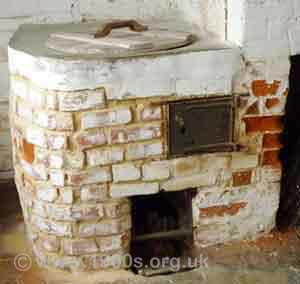
A 'copper' was the only way to heat large amounts of water in Victorian houses. This page describes coppers, explains their name and describes the hard work involved in using them. Later developments in the 1920s and 30s are also discussed. The page is brought to life with firsthand recollections.
____
Extracted from the memoirs of the webmaster's mother (1906-2002) and edited by the webmaster with further research and firsthand contributions from others
Although a kettle on a kitchen fire or kitchen range could supply relatively small amounts of hot water, the 'copper' water heater/boiler was the only means of obtaining hot water in significant amounts - for the laundry on Monday washday, for the (occasional) bath, for cleaning the house, etc.
Yet although coppers were once crucial pieces of household equipment, I never saw one while growing up in the 1940s. All I knew from my mother was that a copper was like a deep cauldron with a lid, built into the corner of the room with a space underneath for the fire.
So began my extensive search for more information.
The search for an original copper and why it wasn't straightforward
The problem with finding out more about coppers turned out to be because they were both built-in and bulky. So although every Victorian and Edwardian house had one and although numerous such houses are still giving good service today, their coppers have understandably been demolished to make room for more modern appliances.
I found that some 'cauldron' parts and lids did survive in museums but they meant little to me by themselves. The occasional museum even had a reconstruction, but it was not plumbed in.
Finally - a surviving copper in its original condition
It took a long search to find an original plumbed-in copper where I could photograph it. (The National Trust properties with coppers did not allow photographs at that time.) Success was in an outhouse at Jane Austen's house in Chawton. In the better-off houses, coppers, like hers, were in outhouses, although in the working class Victorian-style terraces where my mother lived, the copper was in the scullery.

Old copper water heater in the outhouse at Jane Austen's house in Chawton
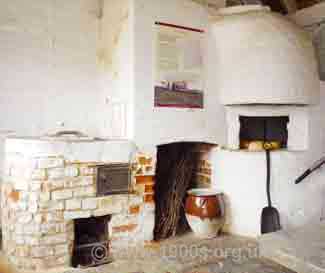
Arrangement whereby the copper, a fireplace and a bread oven all share the same chimney
Seeing an original copper enabled me to make much more sense of the descriptions and the museum exhibits.
Why the name copper
Before going on to explain how coppers worked, let me explain the name.
In wealthier houses, the container for the water really was made of copper which is an excellent conductor of heat, but this was exceptional. The container was generally the cheaper cast-iron, and its size depended on the size of the household which it served. It was rather like a very large deep bucket without a handle. Hence my mother's description likening it to a cauldron.
The cast iron linings of old coppers
contributed by Albert Smith, a recollection and comment
As the sites of housing areas destroyed by WW2 bombing were cleared, many cast iron copper linings were revealed. Most were broken to some degree but those which remained intact reminded me of large upturned bowler hat crowns.
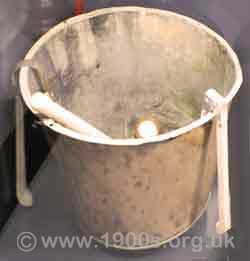
The container for the water from a dismantled copper in Milestones Museum in Basingstoke. It is unusual in that it really is made of copper rather than cast-iron and does not appear to have the more common rounded bottom for easy cleaning. The photo also shows wooden tongs for lifting clothes in and out of the water.
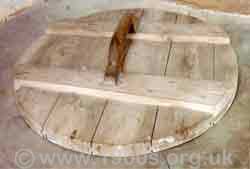
Wooden lid of the copper.
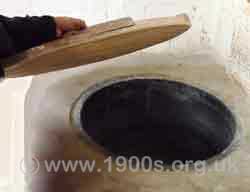
The lid of an original copper lifted to show the cast iron interior.
How the copper was filled with water
Coppers were mainly used on Mondays for the weekly wash - an ardous undertaking with no modern conveniences, made no easier by having to fill the copper with water.
As the container for the water was built-in and could not be removed, the water had to be added with a bucket or ladle which must have been very heavy work. The coppers on the working-class estate where my grandparents lived took about six regular sized bucketfuls to fill.
How the water was heated: a coal fire
The water was heated with a coal fire which was laid and lit through an opening in the brickwork under the water container, and there was an opening to provide a flow of air and to collect the fallen ashes.
Lighting the fire had to be the first task on washdays to give time for it to heat up enough to heat all the water.
The flue or chimney was normally behind the wall against which the copper was built, and it led into a chimney serving another adjacent fire of some sort. On the working-class Huxley Estate where my mother grew up, the adjacent fire was the kitchen range; at Jane Austen's house it was a fireplace and a bread oven.
In some buildings there was a control in the wall of the chimney which could be pushed in and out to control the air flow to the fire and hence the temperature of the hot water.

Air flow control in the wall of the chimney of the copper
The wooden lid kept the inside of the copper clean and also kept in the steam and heat when the copper was in use.
How the copper was emptied of water
contributed by Paulene Allett
Although most coppers had to be filled and emptied with a bucket, we were rather proud that ours had a tap at the bottom for emptying.
A tap so close to a fire would have become too hot to handle, which is probably why most coppers didn't have one. In general, coppers had to be ladled out.
contributed by Julia Wain-Smith
As far as I recall, there was a syphon to empty the copper which ran the water down along the yard.
It wouldn't have been possible to get the last dregs out in either of these ways, so I assume that women wiped round the copper with cloth of some sort.
The copper lid as a toy
contributed by Ken Thawley
As a young boy, I used to enjoy wielding the lid of my grandmother's copper as a shield.
Where to find coppers today
You can usually find a copper or part of one in a large museum, but it is often a reproduction, not connected to a chimney. The first of the following pictures is an example.
Existing original coppers are usually in a decrepit state, located wherever there is enough spare space for no-one to bother to knock them out, as in the second of the following pictures.
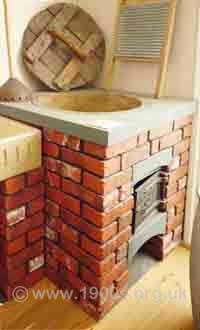
This reconstruction of a copper at Blaise Castle House Museum shows another arrangement for feeding in coals and removing ashes. It is not plumbed into a chimney, and could never actually work.
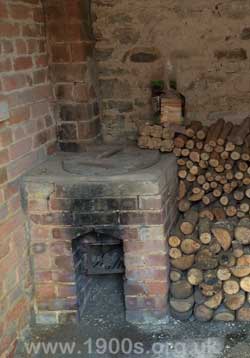
Typical of surviving coppers, found in outhouses or basements used as storerooms, not in kitchens. Photo courtesy of Michael Wright.
Coppers should not be confused with geysers which were popular in the larger, wealthier houses which had separate bathrooms. Geysers could only produce smaller amounts of hot water.
Gas-fired coppers in the 1930s
The following photo shows a development of the old-style Victorian coppers, as used in the 1920s and early 1930s. They were made of aluminium and fired by gas which enabled the following advantages over the older coppers described above.
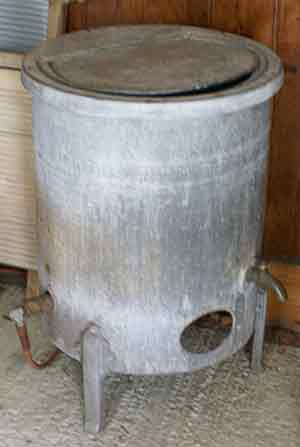
Portable, gas-fired copper water heater/boiler from the 1930s, photographed in Tilford Rural Life Museum. Unfortunately the gas fired mechanism has been lost.
- They were portable as they did not require a chimney
- Being aluminium, they were light to move around
- Being gas-fired, they could be attached to any gas supply, including calor gas.
- They produced hot water much faster than the coal-fired version, letting the room be cooler to work in
Against this, in my view, they were ugly, as they were not builtiin and their aluminium tarnished quick and unevenly.
By the late 1930s, new houses were build with hot water tanks, heated separately by coal-fired water heaters known as 'boilers'. Older houses soon had their plumbing similarly updated, if necessary using electrically powered immersion heaters.
| sources | webmaster | contact |
Text and images are copyright
If you can add anything to this page or provide a photo, please contact me.



